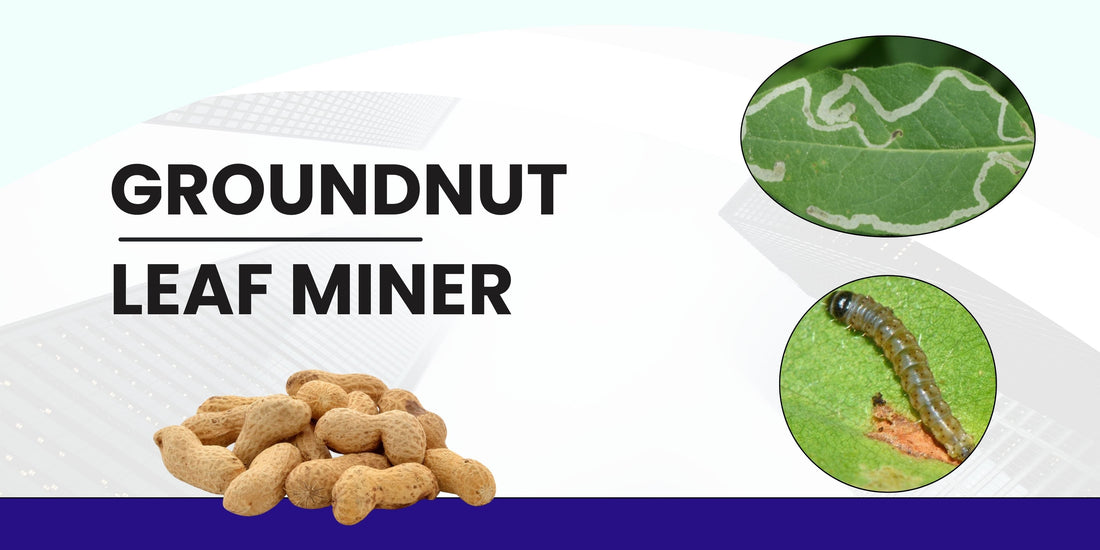
GROUNDNUT LEAF MINER( GLM )
Telugu name: Aaku mudatha purugu
Scientific name: Aproaerema modicella
Identification of the insect pest
- Eggs: Shiny white eggs laid singly on underside of the leaflets.
- Larva: Green coloured with pale brown head and prothroax.
- Pupa: Reddish brown, pupate in white silken cocoons within webbed leaflets.
- Adult: Tiny brown moth about 6 mm in length with a white spot on the costal margin of forewing
- Hindwings with fringed hairs
Life cycle
- Egg: The female adult lays eggs on the underside of groundnut leaves. Eggs are small and oval, often placed in clusters.
- Larva (Mine): Once the eggs hatch, the larvae burrow into the leaf tissue, creating mines (tunnels) inside the leaf. The larvae feed on the leaf tissue as they move within the leaf.
- Pupa: After feeding and growing, the larvae exit the leaf to pupate in the soil.
- Adult: The adult is a small fly that emerges from the pupa. These flies are typically dark-colored and can move quickly.
SYMPTOMS
- Young larvae mine into the leaves and feed the leaflets.
- Short brownish blotches on the leaflets.
- Grown up larvae web the leaflets together, feed on tissues and form brown blister-like blotches.
- In severe infestation, damaged leaflets roll, shrivel, dry up and gives a burnt appearance.
FAVORABLE CONDITIONS
- High temperatures (25-30°C) promote faster reproduction and growth.
- Monocropping of groundnut provides a consistent food source, allowing pest populations to thrive.
Economic Threshold Level (ETL)
Control measures should be initiated if:
- 8-10% of leaves show damage, or there are 5-10 mines per plant.
MANAGEMENT
Cultural Control
- Sow groundnut early and synchronously in rainy and rabi season.
- Intercrop groundnut with pearl millet @ 4:1 ratio.
- Set up light trap @ 1/ha between 8 and 11 PM at ground level.
- Mulch the soil with straw within 10 days after germination wherever possible.
-
Maintain the fields and bunds free from weeds.
Biological Control
- Encourage natural enemies like Bracon hebetor and Trichogramma spp., which parasitize larvae and eggs.
- Predators like ladybird beetles and spiders can help reduce pest populations.
Chemical Control
For effective control we can include insecticides with
- Neem oil or neem-based bio-pesticides are eco-friendly options.
- For effective control of Caterpillar in groundnut bio pesticide like “LARVEX 250 ml / acre” can be used.
FAQ’s
1.What are the symptoms of groundnut leaf miner?
The pest that tunnels through peanut leaves, reducing plant growth and yield,which leads to weakens plants and cuts into profits.
2.What is the best time to check groundnut leaf miners?
Early morning or late afternoon is ideal when pests are more active. Regular inspections during peak growing seasons help catch them early.
3.How can I naturally control groundnut leaf miners?
Introduce beneficial insects like parasitic wasps or use neem oil sprays. Crop rotation also helps break their life cycle.
4.What chemical treatments work against groundnut leaf miners?
Insecticides like LARVEX 250 ml / acre” can be effective. Always follow safety guidelines and rotate chemicals to prevent resistance.
5.Can intercropping help reduce groundnut leaf miner infestations?
Yes, intercropping with non-host plants like maize or millet can disrupt their breeding cycle and lower infestations.
